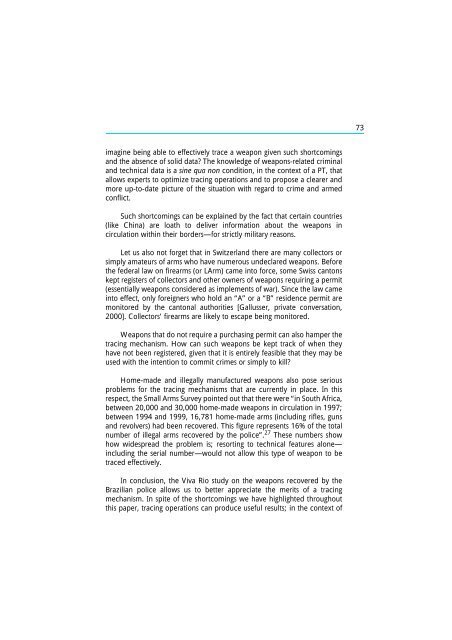The Scope and Implications of a Tracing Mechanism for Small Arms ...
The Scope and Implications of a Tracing Mechanism for Small Arms ...
The Scope and Implications of a Tracing Mechanism for Small Arms ...
You also want an ePaper? Increase the reach of your titles
YUMPU automatically turns print PDFs into web optimized ePapers that Google loves.
73<br />
imagine being able to effectively trace a weapon given such shortcomings<br />
<strong>and</strong> the absence <strong>of</strong> solid data? <strong>The</strong> knowledge <strong>of</strong> weapons-related criminal<br />
<strong>and</strong> technical data is a sine qua non condition, in the context <strong>of</strong> a PT, that<br />
allows experts to optimize tracing operations <strong>and</strong> to propose a clearer <strong>and</strong><br />
more up-to-date picture <strong>of</strong> the situation with regard to crime <strong>and</strong> armed<br />
conflict.<br />
Such shortcomings can be explained by the fact that certain countries<br />
(like China) are loath to deliver in<strong>for</strong>mation about the weapons in<br />
circulation within their borders—<strong>for</strong> strictly military reasons.<br />
Let us also not <strong>for</strong>get that in Switzerl<strong>and</strong> there are many collectors or<br />
simply amateurs <strong>of</strong> arms who have numerous undeclared weapons. Be<strong>for</strong>e<br />
the federal law on firearms (or LArm) came into <strong>for</strong>ce, some Swiss cantons<br />
kept registers <strong>of</strong> collectors <strong>and</strong> other owners <strong>of</strong> weapons requiring a permit<br />
(essentially weapons considered as implements <strong>of</strong> war). Since the law came<br />
into effect, only <strong>for</strong>eigners who hold an “A” or a “B” residence permit are<br />
monitored by the cantonal authorities [Gallusser, private conversation,<br />
2000]. Collectors’ firearms are likely to escape being monitored.<br />
Weapons that do not require a purchasing permit can also hamper the<br />
tracing mechanism. How can such weapons be kept track <strong>of</strong> when they<br />
have not been registered, given that it is entirely feasible that they may be<br />
used with the intention to commit crimes or simply to kill?<br />
Home-made <strong>and</strong> illegally manufactured weapons also pose serious<br />
problems <strong>for</strong> the tracing mechanisms that are currently in place. In this<br />
respect, the <strong>Small</strong> <strong>Arms</strong> Survey pointed out that there were “in South Africa,<br />
between 20,000 <strong>and</strong> 30,000 home-made weapons in circulation in 1997;<br />
between 1994 <strong>and</strong> 1999, 16,781 home-made arms (including rifles, guns<br />
<strong>and</strong> revolvers) had been recovered. This figure represents 16% <strong>of</strong> the total<br />
number <strong>of</strong> illegal arms recovered by the police”. 27 <strong>The</strong>se numbers show<br />
how widespread the problem is; resorting to technical features alone—<br />
including the serial number—would not allow this type <strong>of</strong> weapon to be<br />
traced effectively.<br />
In conclusion, the Viva Rio study on the weapons recovered by the<br />
Brazilian police allows us to better appreciate the merits <strong>of</strong> a tracing<br />
mechanism. In spite <strong>of</strong> the shortcomings we have highlighted throughout<br />
this paper, tracing operations can produce useful results; in the context <strong>of</strong>
















